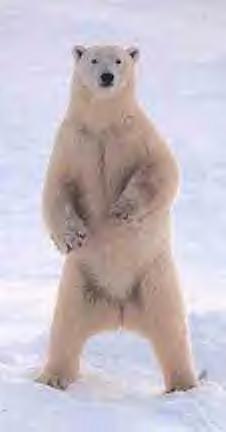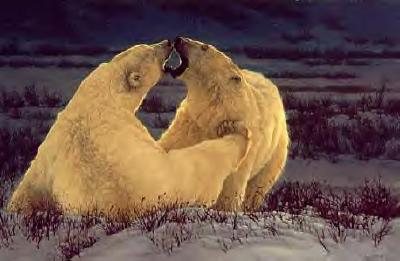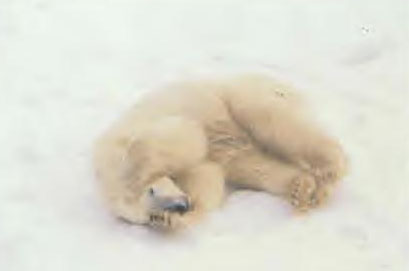|
 In a tribal
village there lived a mighty bear-hunter. For more than three years, he had been constantly successful in killing
so many that his friend tried to persuade him to stop hunting. In a tribal
village there lived a mighty bear-hunter. For more than three years, he had been constantly successful in killing
so many that his friend tried to persuade him to stop hunting.
"If you insist upon hunting one more bear, you will come across a huge bear who might kill you," he said.
The hunter ignored his friend's advice and replied, "I will attack every bear I come across."
A few days later the hunter started out and saw a bear with two cubs. He decided this was not the huge bear he
had been worried about, so he attacked the mother bear, and after some difficulty killed her. The cubs ran away.
After the hunter dragged the bear home for his tribe, his friend continued to urge him to give up the bear hunt,
but without success.
On another hunt, after a few days on the trail, the hunter met a stranger who informed him that near his village
were a great many bears. "Every year many are killed by our hunters, but always there is an invincible one
that has destroyed many of our hunters. Each time he kills a man, the bear tears him apart, examines him carefully
as if searching for a special body mark. He is different because his feet and head are white."
 They parted, and the hunter started out to look for that hunting ground. On his way, he stopped
near a fish creek looking for game, but after a long night none appeared. Next morning he moved onward and came
to a high bluff; below it he saw many bears on the tundra. He waited until some separated and looked over the remainder. They parted, and the hunter started out to look for that hunting ground. On his way, he stopped
near a fish creek looking for game, but after a long night none appeared. Next morning he moved onward and came
to a high bluff; below it he saw many bears on the tundra. He waited until some separated and looked over the remainder.
Among those, he saw the white-faced bear with white feet and concluded that this must be the ferocious, huge bear
he sought. First he would keep an eye on it and wait for a favourable opportunity to kill it.
Now it seems that at one time, the white-faced bear was a human being and a very successful bear-hunter, too successful
for his own good. His friends were envious and plotted to kill him. So they went to a medicine-man deep in the
woods, and begged him to transform the successful hunter into a beast.
"Shoot a bear, skin it and place the skin under the pillow of your successful hunter," advised the shaman.
 After the bear-skin had been prepared, the shaman and his friends quietly went to the man's hut
and placed the skin under the man's pillow. They hid themselves to see what would happen when the man went to bed.
Upon waking, the man found that he had become a huge bear with a white face and white feet. After the bear-skin had been prepared, the shaman and his friends quietly went to the man's hut
and placed the skin under the man's pillow. They hid themselves to see what would happen when the man went to bed.
Upon waking, the man found that he had become a huge bear with a white face and white feet.
"The white marks will show you which bear he is," said the shaman, who disappeared into the woods.
Now our bear-hunter still sat at the edge of the bluff. Toward evening he saw the bears begin to leave, all except
the white- faced bear. He was the last to get up, and he shook himself three times and acted as if he was deeply
enraged. He moved toward the bluff where the hunter sat perfectly still. But the bear approached, and when he was
almost face to face, asked, "What are you doing here?"
"I came out to hunt," he replied.
"Is it not enough that you have killed all my family, and recently killed my wife, and now you want to take
my life? If you had injured my children the other day, I would now tear you to pieces. I will, however, spare your
life this time on your promise that you will never hunt bears again. All the bears you saw today are my children
and of my brother. Should I ever see you hunting bear, I will tear you apart."
Relieved to get away so easily, the hunter headed homeward. His friend met him and inquired about the white-faced
bear, and when told what had happened, he urged the hunter to give up hunting. A whole week passed before the hunter
set forth again, taking along six hunting friends.
 For two days they hunted without luck, then came to the fish creek where they camped overnight.
Next morning their leader took the six to the edge of the bluff where they could look down at the tundra and see
many bears. But they could not see the white- faced bear and, encouraged, followed their leader toward the animals. For two days they hunted without luck, then came to the fish creek where they camped overnight.
Next morning their leader took the six to the edge of the bluff where they could look down at the tundra and see
many bears. But they could not see the white- faced bear and, encouraged, followed their leader toward the animals.
"Look at that strange-looking beast with white paws and a white face!" exclaimed one man.
The hunter-leader caught sight of that special bear and ordered his followers to retreat at once. So they went
around another mountain where they saw many bears. They killed seven, one for each man.
Loaded with their spoil they took the homeward trail, but a short distance behind them they heard a commotion.
They saw the white faced bear rapidly approaching them. The hunter aimed, but his bowstring broke. The others shot
and missed. The white-faced bear spoke up and said, "Why do you shoot at me? I never harm you. Your leader
killed my wife and nearly all my family. I warned him that if I found him hunting again, I would tear him apart.
And this I shall do now, piece by piece. The rest of you can go. I'll not harm you because you have not harmed
me."
Hurriedly, as fast as possible, the six men fled. The white- faced bear turned to the bear-hunter.
 "I had you in my power once and I let you go on your promise not to hunt bear again. Now you
are back at it and brought more bear- hunters along. This time I will do to you as you have done to mine." "I had you in my power once and I let you go on your promise not to hunt bear again. Now you
are back at it and brought more bear- hunters along. This time I will do to you as you have done to mine."
The hunter pleaded to be allowed to live one more night so he could go home. At first the bear refused outright.
The white- faced bear then relented, and would even spare his life entirely, if the hunter would tell him who had
transformed him from a man into a beast. The hunter agreed to meet him the next night and go to the home of the
shaman.
When the bear-hunter reached home and found his six companions talking excitedly about the day's experience, they
were surprised to see the hunter-leader alive.
The hunter told them his plan to meet the white-faced bear at the home of the shaman next evening and asked the
six to go with him. They refused and tried to dissuade their leader. But the bear- hunter kept his word and met
the white-faced bear at the appointed place. A light shone from every hut except that of the shaman.
"This is the place," said the man.
"I will remain here," ordered the bear. "You go inside and tell him there is a man outside wishing
to speak with him."
 The man advanced and found the skin-door tied, so he reported to the bear that the shaman must
be out. The bear ordered him back to cut the door, then walk in. Upon entering, the man heard someone call, "Who
dares come into my lodge?" The man advanced and found the skin-door tied, so he reported to the bear that the shaman must
be out. The bear ordered him back to cut the door, then walk in. Upon entering, the man heard someone call, "Who
dares come into my lodge?"
"It is I," said the bear-hunter.
"What do you wish?"
"There is a man outside who wishes to speak to you."
Had the shaman not been so sleepy, he might have been suspicious. Under the circumstances, his mind was not clear
and he fell into the trap.
When the shaman came near the white-faced bear, the old man became frightened and was ready to run away. But the
bear blocked his way and said, "For years you have tortured me and made my life a burden in this condition.
I demand you give me back my human form immediately, otherwise I shall tear you to pieces."
The shaman promised to do so if the bear would follow him into his hut. Before going in, the bear said to the hunter,
"Meet me here when I come out."
 All night the shaman worked hard with the bear, and by next morning succeeded in pulling off the
bear-skin, and a human form appeared. The shaman asked to keep the white-faced bear's skin, but the man kept the
white-face and the white claws, which he cut off at once, giving the rest of the skin to the shaman. All night the shaman worked hard with the bear, and by next morning succeeded in pulling off the
bear-skin, and a human form appeared. The shaman asked to keep the white-faced bear's skin, but the man kept the
white-face and the white claws, which he cut off at once, giving the rest of the skin to the shaman.
"If you ever again try to transform a man into a beast, I will be back and kill you dead, dead, dead,"
said the man.
The next day when the bear-man met the bear-hunter he said, "I caution you against ever going out to hunt
bear. You may even hear people say I've become a bear again, and they will hunt me. Don't you join them. If I find
you in their company, I will kill you dead, dead, dead."
For about four weeks the hunter remained at home with every intention of keeping his promise to the transformed
man. But one day two young men from the neighbouring tribal village came to beg his assistance. They asked his
help to kill a ferocious bear with a white face and four white feet.
Of course the hunter knew the bear they feared, but decided to disguise himself and go help them. They gathered
all of the village warriors and set out to find the white-faced bear. The bear saw them coming. He rose and shook
himself three times, giving the impression of great anger, which frightened the warriors. Their chief said, "We
are in great danger, so we must stand and fight."
 Madly, the white-faced bear jumped, landed in front of the hunter and tore him to pieces. Then
it pawed a hole in the ground and covered up the parts. The terrified warriors tried to escape, but the white-faced
bear chased them back to their village, tearing them apart, killing all of them, including the old shaman. Finished,
the white-faced bear turned back into the woods to rest undisturbed forever. Madly, the white-faced bear jumped, landed in front of the hunter and tore him to pieces. Then
it pawed a hole in the ground and covered up the parts. The terrified warriors tried to escape, but the white-faced
bear chased them back to their village, tearing them apart, killing all of them, including the old shaman. Finished,
the white-faced bear turned back into the woods to rest undisturbed forever.
Print and Color your own White Faced Bear
Bear

|

![]()
![]()
 In a tribal
village there lived a mighty bear-hunter. For more than three years, he had been constantly successful in killing
so many that his friend tried to persuade him to stop hunting.
In a tribal
village there lived a mighty bear-hunter. For more than three years, he had been constantly successful in killing
so many that his friend tried to persuade him to stop hunting. One of the
most persistent myths about the polar bear is that a hunting bear will cover its black nose while lying in wait
for a seal. The legend is widespread among native hunters. Canadian biologist Ian Stirling has spent several thousand
hours watching polar bears hunt. He has never seen one hide its nose, nor have other scientists.
One of the
most persistent myths about the polar bear is that a hunting bear will cover its black nose while lying in wait
for a seal. The legend is widespread among native hunters. Canadian biologist Ian Stirling has spent several thousand
hours watching polar bears hunt. He has never seen one hide its nose, nor have other scientists.
 Polar
bears are the largest land carnivore. Male polar bears or boars can weigh around 350 to 650 kg (772-1,433 lb.)
and are about 2.5 to 3 m (8.2-9.8 ft.) long. Females or sows weigh about 150 to 250 kg (331-551 lb.) and are about
2 to 2.5 m (6.6-8.2 ft.) long. Both males and females have small tails that are about 7 to 12 cm (2.8-4.7 in.)
long.
Polar
bears are the largest land carnivore. Male polar bears or boars can weigh around 350 to 650 kg (772-1,433 lb.)
and are about 2.5 to 3 m (8.2-9.8 ft.) long. Females or sows weigh about 150 to 250 kg (331-551 lb.) and are about
2 to 2.5 m (6.6-8.2 ft.) long. Both males and females have small tails that are about 7 to 12 cm (2.8-4.7 in.)
long.  Polar bears are strong swimmers. They can swim for several hours at a time over long distances
and reach speeds of 10 kph (6.2 mph). Polar bears swim using the famous doggy-paddle style. The front paws are
used to propel them and their hind feet and legs are used for steering. The average walking speed of a polar bear
is 5.5 kph (3.4 mph) and they can run as fast as 40 kph (25 mph) but only for short distances.
Polar bears are strong swimmers. They can swim for several hours at a time over long distances
and reach speeds of 10 kph (6.2 mph). Polar bears swim using the famous doggy-paddle style. The front paws are
used to propel them and their hind feet and legs are used for steering. The average walking speed of a polar bear
is 5.5 kph (3.4 mph) and they can run as fast as 40 kph (25 mph) but only for short distances. They have excellent sense of smell, which helps them to detect food. Polar bears are mainly carnivores,
eating seals, walrus, whale, fish, small rodents, seabirds, and reindeer, as well as berries and various plants
in the summer. Polar bears need an average of 2 kg (4.4 lb.) of fat per day to survive.
They have excellent sense of smell, which helps them to detect food. Polar bears are mainly carnivores,
eating seals, walrus, whale, fish, small rodents, seabirds, and reindeer, as well as berries and various plants
in the summer. Polar bears need an average of 2 kg (4.4 lb.) of fat per day to survive. Polar bears are solitary animals. Basically only coming together to mate, share a large food source
such as a dead whale or when a female has young. They are most active for the first part of the day and least active
at the end of the day. They spend most of their time hunting, swimming, sleeping or resting. Polar bears don't
enter deep hibernation (that's they go into a dormant or sleepy state during winter). Only pregnant female polar
bears hibernate.
Polar bears are solitary animals. Basically only coming together to mate, share a large food source
such as a dead whale or when a female has young. They are most active for the first part of the day and least active
at the end of the day. They spend most of their time hunting, swimming, sleeping or resting. Polar bears don't
enter deep hibernation (that's they go into a dormant or sleepy state during winter). Only pregnant female polar
bears hibernate.